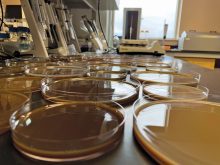The Netley-Libau Nutrient-Bioenergy Project has been recognized by the Manitoba Round Table for Sustainable Development as it seeks commercial opportunities for its findings.
After receiving the award for Innovation and Research for Sustainability at the Manitoba legislature, lead researcher Richard Grosshan said the focus of the project has changed since he began work at the marsh in 2006.
“It’s one of the surprising things,” Grosshan said. “When we first started, we were primarily doing it for nutrient management, and now much of the focus is on the potential for bioenergy.”
Read Also

The joys of fishing from shore
Manitoba has many lake and river shorelines to drop a fishing line without the cost of a boat, making shore fishing more accessible, and anglers can still catch impressive fish.
For example, project staff have harvested cattails from the Netley-Libau Marsh and turned them into pellets able to replace coal as a fuel. The process used is one that can be duplicated anywhere cattails are plentiful.
And interest in the process is growing, said Grosshan.
“We now have a partnership with Minnesota, where they are also doing research and looking at starting a similar program,” he said.
Other regions, including in Ontario and as far away as Florida, have also expressed interest in the Netley-Libau project, he added.
“Florida has an issue with nuisance cattails and this is one way to address that,” Grosshan said.
The project, a partnership with the University of Manitoba, Ducks Unlimited Canada, and the International Institute for Sustainable Development’s Water Innovation Centre, has also provided information about bioenergy useful in other applications to create a value-added, low-carbon biofuel.
“Right now we are looking at applications within the agricultural region, looking at obvious areas to get cattails from, such as storm water ditches, retention ponds and things like that,” said the researcher.
But the project hasn’t lost sight of the other benefits the marsh and its cattails provide, such as habitat development, flood mitigation and nutrient management.
Comprised of shallow lakes, channels and wetland, the marsh occupies 250 square kilometres at the mouth of the Red River, offering a valuable opportunity to prevent extra phosphorus from entering Lake Winnipeg.
For every hectare of cattails, between 20 and 40 kilograms of phosphorus can be harvested, Grosshan said.
“And that doesn’t include the phosphorus trapped in the stalks and the roots,” he added.


















